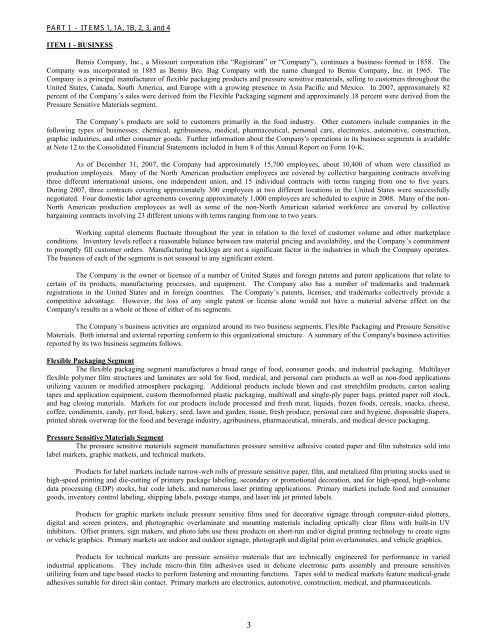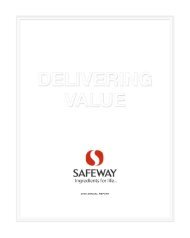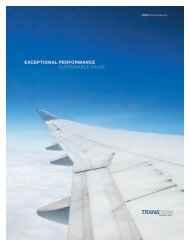Bemis Company 2007 Annual Report - IR Solutions
Bemis Company 2007 Annual Report - IR Solutions
Bemis Company 2007 Annual Report - IR Solutions
You also want an ePaper? Increase the reach of your titles
YUMPU automatically turns print PDFs into web optimized ePapers that Google loves.
PART I - ITEMS 1, 1A, 1B, 2, 3, and 4<br />
ITEM 1 - BUSINESS<br />
<strong>Bemis</strong> <strong>Company</strong>, Inc., a Missouri corporation (the “Registrant” or “<strong>Company</strong>”), continues a business formed in 1858. The<br />
<strong>Company</strong> was incorporated in 1885 as <strong>Bemis</strong> Bro. Bag <strong>Company</strong> with the name changed to <strong>Bemis</strong> <strong>Company</strong>, Inc. in 1965. The<br />
<strong>Company</strong> is a principal manufacturer of flexible packaging products and pressure sensitive materials, selling to customers throughout the<br />
United States, Canada, South America, and Europe with a growing presence in Asia Pacific and Mexico. In <strong>2007</strong>, approximately 82<br />
percent of the <strong>Company</strong>’s sales were derived from the Flexible Packaging segment and approximately 18 percent were derived from the<br />
Pressure Sensitive Materials segment.<br />
The <strong>Company</strong>’s products are sold to customers primarily in the food industry. Other customers include companies in the<br />
following types of businesses: chemical, agribusiness, medical, pharmaceutical, personal care, electronics, automotive, construction,<br />
graphic industries, and other consumer goods. Further information about the <strong>Company</strong>'s operations in its business segments is available<br />
at Note 12 to the Consolidated Financial Statements included in Item 8 of this <strong>Annual</strong> <strong>Report</strong> on Form 10-K.<br />
As of December 31, <strong>2007</strong>, the <strong>Company</strong> had approximately 15,700 employees, about 10,400 of whom were classified as<br />
production employees. Many of the North American production employees are covered by collective bargaining contracts involving<br />
three different international unions, one independent union, and 15 individual contracts with terms ranging from one to five years.<br />
During <strong>2007</strong>, three contracts covering approximately 300 employees at two different locations in the United States were successfully<br />
negotiated. Four domestic labor agreements covering approximately 1,000 employees are scheduled to expire in 2008. Many of the non-<br />
North American production employees as well as some of the non-North American salaried workforce are covered by collective<br />
bargaining contracts involving 23 different unions with terms ranging from one to two years.<br />
Working capital elements fluctuate throughout the year in relation to the level of customer volume and other marketplace<br />
conditions. Inventory levels reflect a reasonable balance between raw material pricing and availability, and the <strong>Company</strong>’s commitment<br />
to promptly fill customer orders. Manufacturing backlogs are not a significant factor in the industries in which the <strong>Company</strong> operates.<br />
The business of each of the segments is not seasonal to any significant extent.<br />
The <strong>Company</strong> is the owner or licensee of a number of United States and foreign patents and patent applications that relate to<br />
certain of its products, manufacturing processes, and equipment. The <strong>Company</strong> also has a number of trademarks and trademark<br />
registrations in the United States and in foreign countries. The <strong>Company</strong>’s patents, licenses, and trademarks collectively provide a<br />
competitive advantage. However, the loss of any single patent or license alone would not have a material adverse effect on the<br />
<strong>Company</strong>'s results as a whole or those of either of its segments.<br />
The <strong>Company</strong>’s business activities are organized around its two business segments, Flexible Packaging and Pressure Sensitive<br />
Materials. Both internal and external reporting conform to this organizational structure. A summary of the <strong>Company</strong>'s business activities<br />
reported by its two business segments follows.<br />
Flexible Packaging Segment<br />
The flexible packaging segment manufactures a broad range of food, consumer goods, and industrial packaging. Multilayer<br />
flexible polymer film structures and laminates are sold for food, medical, and personal care products as well as non-food applications<br />
utilizing vacuum or modified atmosphere packaging. Additional products include blown and cast stretchfilm products, carton sealing<br />
tapes and application equipment, custom thermoformed plastic packaging, multiwall and single-ply paper bags, printed paper roll stock,<br />
and bag closing materials. Markets for our products include processed and fresh meat, liquids, frozen foods, cereals, snacks, cheese,<br />
coffee, condiments, candy, pet food, bakery, seed, lawn and garden, tissue, fresh produce, personal care and hygiene, disposable diapers,<br />
printed shrink overwrap for the food and beverage industry, agribusiness, pharmaceutical, minerals, and medical device packaging.<br />
Pressure Sensitive Materials Segment<br />
The pressure sensitive materials segment manufactures pressure sensitive adhesive coated paper and film substrates sold into<br />
label markets, graphic markets, and technical markets.<br />
Products for label markets include narrow-web rolls of pressure sensitive paper, film, and metalized film printing stocks used in<br />
high-speed printing and die-cutting of primary package labeling, secondary or promotional decoration, and for high-speed, high-volume<br />
data processing (EDP) stocks, bar code labels, and numerous laser printing applications. Primary markets include food and consumer<br />
goods, inventory control labeling, shipping labels, postage stamps, and laser/ink jet printed labels.<br />
Products for graphic markets include pressure sensitive films used for decorative signage through computer-aided plotters,<br />
digital and screen printers, and photographic overlaminate and mounting materials including optically clear films with built-in UV<br />
inhibitors. Offset printers, sign makers, and photo labs use these products on short-run and/or digital printing technology to create signs<br />
or vehicle graphics. Primary markets are indoor and outdoor signage, photograph and digital print overlaminates, and vehicle graphics.<br />
Products for technical markets are pressure sensitive materials that are technically engineered for performance in varied<br />
industrial applications. They include micro-thin film adhesives used in delicate electronic parts assembly and pressure sensitives<br />
utilizing foam and tape based stocks to perform fastening and mounting functions. Tapes sold to medical markets feature medical-grade<br />
adhesives suitable for direct skin contact. Primary markets are electronics, automotive, construction, medical, and pharmaceuticals.<br />
3







